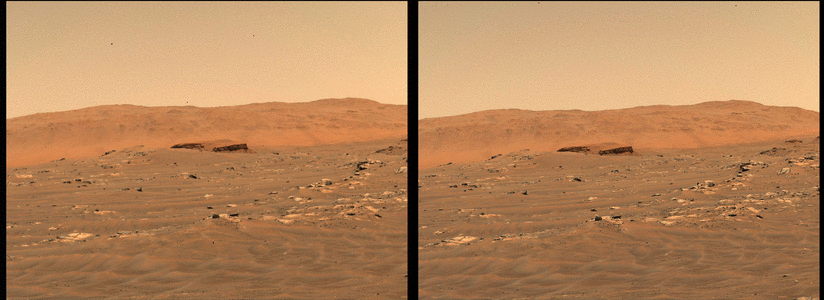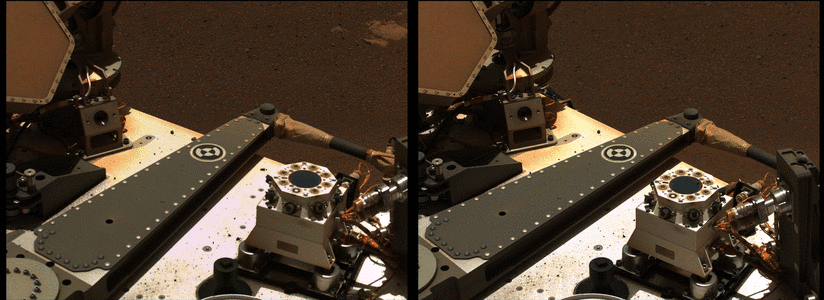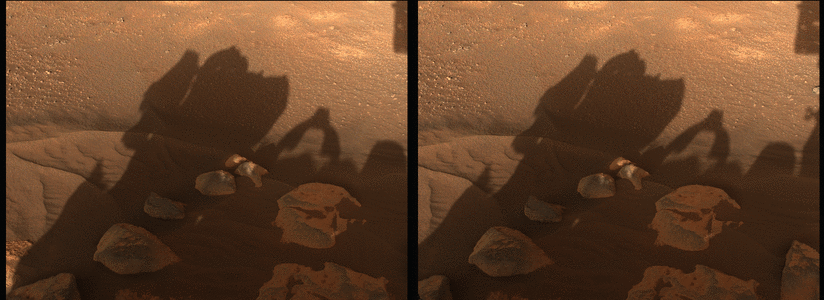
2021-07-12
Zoom, Zoom!
contributed by Jim Bell
We landed on Mars nearly five months ago now, but we’re still learning how to operate the cameras and other instruments on Perseverance. On each of the Mastcam-Z cameras, we’ve got three tiny motors (the engineers call them “actuators”), each about the size of a pinkie finger, that operate the filter wheel, focus, and zoom mechanisms. This kind of camera system has used similar filter wheel and focus motor systems previously – as parts of the Curiosity rover’s Mastcam cameras (which are still working great, along with the rest of that rover, after more than 3159 sols on the Red Planet!). But no one’s ever sent a zoom lens to Mars before.
As shown in the CAD animation below, the Mastcam-Z (short for Mast Cameras Zoom) zoom motor spins a small rotating cylinder and cam shaft that slides two groups of lenses back and forth along a rail. As the distance between the groups of lenses varies, the focal length and field of view of the camera changes. It’s a fairly common configuration for a zoom lens design like you’d find in a commercial off the shelf lens, but of course the design had to be substantially ruggedized to handle the vibrations and shocks of launch and landing, and the materials and electronics had to be designed and tested to be able to withstand operations in a temperature and pressure environment much harsher than Earth’s.

One of the aspects of this zoom lens design that we realized when we started the design process back in 2014 is that the eventual performance of the lenses – the way they focus and how much zoom they provide – is sensitive to temperature. Because we knew that the cameras would be going through some pretty big temperature swings on Mars every day (typical temperatures in Jezero have ranged from a high of around -10°C (+14 °F) in the mid-afternoon to a low of around -80°C (-112 °F) just before dawn), we made some predictions during the design process about how much the cameras and lenses would change with temperature. The prediction was that the changes would be relatively small, but big enough to make our images not focus properly if we didn’t compensate.
The other potential problem that we realized early on is that our cameras are riding on a mast, and the performance of that mast also depends on temperature. Both Curiosity and Perseverance use the same kind of mast (indeed, Perseverance’s is built mostly from spare parts from Curiosity’s). We refer to the mast as the “RSM”, which stands for “Remote Sensing Mast”, because the instruments that ride along on that mast don’t actually contact the surface – like the drill or other instruments on the rover’s arm – but instead “remotely sense” the scene around us. The RSM is what points the Mastcam-Z cameras (and the Navcams, and the SuperCam telescope) at different azimuths (left-right positions) and elevations (up-down positions), allowing us to put individual images together into the spectacular mosaics (relatively small numbers of images covering relatively small fractions of the terrain around the rover) and panoramas (image collections with much larger 180° to 360° coverage) that we’ve been collecting. But since the accuracy of the RSM pointing depends on temperature, we knew ahead of time that we’d have to figure that out, too, in order to build the best possible panoramas.
We were able to do some testing of the cameras and the RSM on Earth before launch, from mid-2018 through early 2020. Most of these tests were done in room temperature conditions in the big High Bay/Cleanroom at JPL where the rover was assembled and tested, like in the images below. A small number of tests were also done over Mars-like temperatures with the rover in a giant thermal vacuum chamber at JPL, but because time in such facilities is extremely limited and we can’t image targets beyond the nearby walls of the chamber, we weren’t able to fully test the cameras and the RSM in the same ways that we expected to use them after landing. We knew, then, that we’d ultimately have to do those tests on Mars.

So that’s partly what we’ve been doing since landing on February 18 of this year. While many of the Mastcam-Z images, mosaics, and panoramas have been taken for scientific use (geology, topography, texture, composition, atmospheric monitoring, etc.), many other sets of images have been and continue to be taken as part of Mastcam-Z’s “instrument characterization” campaign. All of the rover’s science instruments and engineering systems have been doing these kinds of characterization and calibration campaigns since landing, helping the team learn how the instruments, and indeed the whole rover, behaves now that its in its “native habitat” on Mars.
So we’ve been zooming in and out, pointing at various targets near and far, working to understand exactly how the Mastcam-Z cameras and the RSM behave at different temperatures and from sol-to-sol on Mars. The first animated set of images below, for example, show some images from a multi-zoom test pointed at one of the reference marks or “fiducial targets” on the rover’s deck. The precise locations of those fiducials relative to the cameras and other features on the rover were very accurately surveyed and recorded before launch. So watching their apparent positions in our images shift as a function of zoom and temperature helps us really understand how the cameras are performing.

Another kind of multi-zoom test sequence that we’ve been doing is called a “stare test” because we just stare at the same patch of ground, at multiple zoom levels, at many different times of sol, and thus many different camera temperatures. These allow us to characterize both the changes in pointing close to the rover as well as the changes in focus or image quality/resolution as the temperature changes. The stare test imaging sequence below, for example, was run at three different times on sol 93 (the one shown here had the most dramatic low-Sun lighting, including the Optimus Prime-like shadow of the rover itself!).

We’ve also done some pointing and resolution tests for distant targets, like the “pointing test” below that was run on sol 121. The 2.5-km distant delta remnant that we call Kodiak was a great target for a zoom test like this, because it shows a lot of fine-scale features at our highest resolution zoom setting.

We’re continuing to learn more and more about how these cameras perform on Mars, and how best to take pictures with them, as the mission continues. But we still need to do some more stare tests and other zoom tests at different temperatures, which we will try to squeeze in now and then around an already busy schedule of Mastcam-Z imaging for science and rover engineering support. So watch for lots more zoom, zoom, zooming from Mastcam-Z as we all explore Jezero crater together!
[Note: The Mars images shown here can also be downloaded from the NASA/JPL Perseverance rover “Raw Images” web site, at https://mars.nasa.gov/mars2020/multimedia/raw-images.]